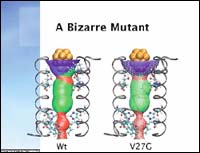‘Defensive’ Action By Influenza Viruses

Illustration #1 shows the “conventional mutant” action of an influenza virus, in which the channel-blocking element (brown cluster) seals the virus’ channel at left, while at right the virus has narrowed its own channel to prevent the blocker from binding and sealing. In Illustration #2, the “bizarre mutant,” the channel-blocking element (brown cluster) is seen effectively working in the virus at left, while at right the virus has widened its entry point to allow the blocker in, but not to seal.
Combating viruses is often a frustrating business. Find a way to destroy them — and before you know it, they’ve found a way to defend themselves and neutralize the anti-viral treatment.
How, exactly, do the viruses do it? In an article published as the cover story in a recent issue of the journal Proteins, a Hebrew University of Jerusalem researcher, Prof. Isaiah (Shy) T. Arkin, has revealed just how influenza-causing viruses adapt to nullify the effectiveness of the anti-viral drug symmetrel (generic name). The revelation can have significant consequences in leading drug researchers to develop new and more effective means to block influenza and other viruses in the future.
Influenza, Prof. Arkin emphasizes, is a major killer, even though many people tend to shrug it off as an unpleasant seasonal nuisance. In the U.S. it is the leading cause of death from infectious diseases, claiming about 40,000 lives annually, mostly among the elderly.
In his research, Arkin, of the Department of Biological Chemistry at the Hebrew University’s Silberman Institute of Life Sciences, has demonstrated how flu viruses counteract the symmetrel drug. Assisting him in his work were graduate students Peleg Astrahan and Itamar Kass, as well as Dr. Matt Cooper from Cambridge University in Britain.
Administered at an early stage at the onset of flu symptoms, symmetrel is intended to destroy the virus by binding to and blocking a proton-conducting channel which the virus needs in order to continue functioning and multiplying.
Rather than conceding defeat, however, the virus takes its own counteractions: either by narrowing its channel to the extent that the blocking element in the drug is unable to bind and create a seal, or by widening its channel so that the blocker can get in, but can’t totally seal the channel. Arkin notes that the latter action is the more surprising and unexpected one.
While counteraction of the virus to the drug has been previously noted, this is the first time that the activity that lies behind this phenomenon has been demonstrated, said Arkin. This is because researchers had previously only concentrated on examining the binding action of the blocker to the viruses, but not the process taking place in the viruses’channel. Thus, there was only a limited picture of what was actually happening.
This new information on the mutating abilities of the influenza virus will have to be taken into consideration in further anti-viral research, said Arkin.
Media Contact
More Information:
http://www.huji.ac.ilAll latest news from the category: Health and Medicine
This subject area encompasses research and studies in the field of human medicine.
Among the wide-ranging list of topics covered here are anesthesiology, anatomy, surgery, human genetics, hygiene and environmental medicine, internal medicine, neurology, pharmacology, physiology, urology and dental medicine.
Newest articles

Properties of new materials for microchips
… can now be measured well. Reseachers of Delft University of Technology demonstrated measuring performance properties of ultrathin silicon membranes. Making ever smaller and more powerful chips requires new ultrathin…

Floating solar’s potential
… to support sustainable development by addressing climate, water, and energy goals holistically. A new study published this week in Nature Energy raises the potential for floating solar photovoltaics (FPV)…

Skyrmions move at record speeds
… a step towards the computing of the future. An international research team led by scientists from the CNRS1 has discovered that the magnetic nanobubbles2 known as skyrmions can be…





















